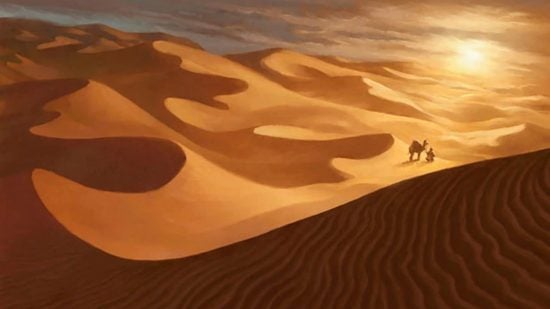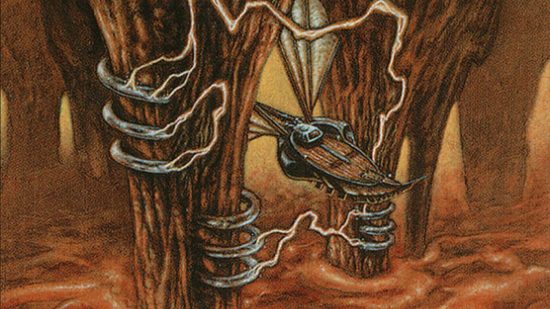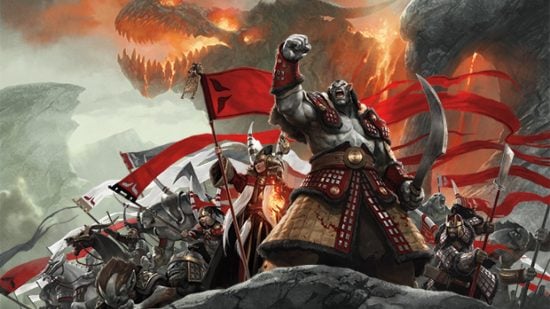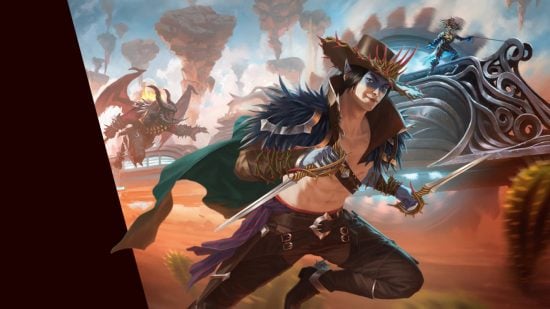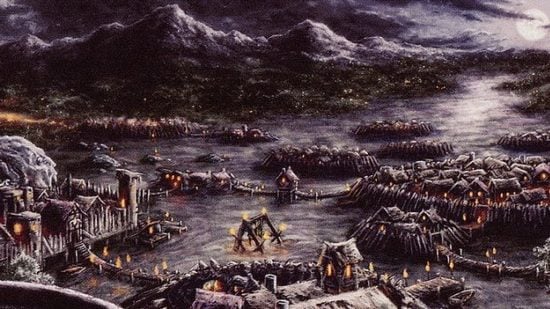There are dozens of planes in Magic: The Gathering’s extensive multiverse. But not all MTG planes are made equal. While some rival the depth of Dominaria with detailed cosmologies, a roster of gods, and multiple factions, others have scant little revealed about them. Here, you’ll find information on the 29 most important planes in Magic history.
This guide has details on every plane that has ever been the setting of a mainline MTG set, from Alara to Zendikar. Reach the end, and you can consider yourself a Magic: The Gathering lore expert. Now, without further ado, let’s make like an MTG planeswalker and get plane-hopping.
Alara
The mana-rich plane of Alara was ransacked by a planeswalker in ancient times, which shattered the world into five shards, each inhabited by three colors of mana. The absence of two colors of Magic warped each of these miniature planes beyond recognition.
These shards are:
- Bant (white/green/blue): An orderly world full of castles, lion-riding knights, and angels.
- Esper (blue/white/black): A mage-controlled world full of machines and magical filigree.
- Grixis (black/red/blue): A horrible world of undead, demons, nightmares, and horrors.
- Jund (red/green/black): A wild world of volcanoes and jungles, where might makes right.
- Naya (green/white/red): A luscious tropical world ruled by elves, with giant creatures.
As you might have noticed, these shards give certain MTG color combinations their nicknames.
After eons apart, Alara was eventually reunited in an event called the Conflux. This created turmoil, as wars sprung up in incursion zones, where the shards were joined, and their inhabitants suddenly thrust together.
Sets on Alara: Shards of Alara (2008), Conflux (2009), Alara Reborn (2009)
Native planeswalkers: Ajani (Naya), Tezzeret (Esper)
Amonkhet
Amonkhet is an Ancient Egyptian inspired plane covered in deserts and pyramids, and containing creatures like jackal men, as well as animal-headed gods. The dead come back to life on Amonkhet, and if prepared properly, become mummy servants.
MTG villain Nicol Bolas warped this plane some time before we first saw it, shaping the culture to his own ends. He set up deadly trials of the gods, which were deemed holy and righteous until it was revealed that Bolas was using them to make a zombie army.
With Bolas’ plan revealed, Amonkhet was plunged into an apocalypse, which killed all but one of its gods.
Sets on Amonkhet: Amonkhet (2017), Hour of Devastation (2017)
Native planeswalkers: Basri Ket, Samut
Arcavios
Arcavios is an MTG plane best known for its school of magic, Strixhaven, opened by elder dragons to bring peace and education to the once war-torn land.
Right now, most of what we’ve seen of this world concerns the school and its five colleges. Lorehold is a red/white college of history and archeology, Silverquill a black/white college of poetry and oration, Prismari a red/blue college of art and performance, Witherbloom a green/black college of natural sciences, and Quandrix a green/blue college of mathematics. All five use their academic disciplines in a magical manner.
The world is also inhabited by ancient, multi-armed giants, named Archaics, and has an evil secret society of mages called the Oriq.
Sets on Arcavios: Strixhaven (2021)
Native planeswalkers: Quintorius Kand
Bablovia
An unset world filled with mad scientists, Bablovia is inhabited by factions like the Order of the Widget and the Goblin Explosioneers.
As well as the scientists mixing up animals, creating cyborgs and blowing themselves up, there are supervillains seeking to take over the world and spies utilizing cool gadgets. T’is a silly place: the setting of a silver-bordered set, Bablovia is not really part of the main ‘canon’ multiverse.
Sets on Bablovia: Unstable (2017)
Bloomburrow
Bloomburrow is a plane inhabited by anthropomorphic animals, with absolutely no humans lurking alongside all the mice, bats, frogs, rabbits, etc. In fact, it seems like traveling to Bloomburrow will temporarily transform you into an animal person.
A major threat on Bloomburrow are the elemental ‘calamity beasts’, giant elemental animals which don’t appear to be sentient.
Sets on Bloomburrow: Bloomburrow (2024)
Capenna
A plane that was devastated by an old Phyrexian invasion. The only settlement on the plane is the metropolis of New Capenna, a demon-filled city of gangster-inspired crime. With everything from corrupt lawyers to art collecting vampires to deal with, and no form of law enforcement outside of the competing mafia-like gangs, the average Joe on this plane is in for a bad time.
During the Phyrexian invasion, angels came back to Capenna, which is likely to shake things up a bit in any future revisit.
Capenna is inspired by 1920s era America, featuring flappers, art deco architecture, and Magic: The Gathering’s take on a tommy gun.
Sets on Capenna: Streets of New Capenna (2022)
Dominaria
This one’s tricky to sum up. For years, Dominaria was Magic: The Gathering’s primary setting, and no other world in the multiverse has been fleshed out in such detail. Dominaria has lots of distinct factions, from the Tolarian wizards to the Llanowar elves. It has varied terrain, with a detailed world map including multiple continents, and has been host to some of the game’s most important events.
These include The Brother’s War and resulting Ice Age; the Phyrexian invasion, which set up the MTG Phyrexians as one of the game’s primary villains; and the Mending, which made planeswalking more difficult and changed the power level of planeswalkers.
Sets on Dominaria: Alpha/Beta/Unlimited (1993), Antiquities (1994), Legends (1994), The Dark (1994), Fallen Empires (1994), Ice Age (1995), Alliances (1996), Mirage (1996), Weatherlight (1997), Visions (1997), Portal (1997), Portal: Second Age (1998), Urza’s Saga (1998), Urza’s Legacy (1999), Urza’s Destiny (1999), Prophecy (2000), Invasion (2000), Planeshift (2001), Apocalypse (2001), Odyssey (2001), Torment (2002), Judgment (2002), Onslaught (2002), Legions (2003), Scourge (2003), Coldsnap (2006), Time Spiral (2006), Planar Chaos (2007), Future Sight (2007), Dominaria (2018), Dominaria United (2022), The Brothers War (2022), Dominaria Remastered (2022)
Native planeswalkers: Dakkon Blackblade, Freyalise, Jared Carthalion, Jaya Ballard, Jeska, Karn, Liliana Vess, Lord Windgrace, Nicol Bolas, Teferi, Tevesh Szat, Ugin, Urza, Venser
Duskmourn
Duskmourn is a horror-themed plane that may well be entirely inside an enormous house, though Wizards of the Coast hasn’t made this explicit yet. That house is extremely haunted, full of creeps and spooks based on modern horror tropes. It seems like the very house itself might be alive, and perhaps even partially organic.
Sets on Duskmourn: Duskmourn (2024)
Eldraine
Eldraine is a plane inspired both by fairy tales and Arthurian legends. Here you’ll find interesting spins on classic fairy tales, as well as half a dozen big bad wolves, wicked witches, and fairy godmothers. That’s the Wilds, but there’s also the Realm, a bunch of knightly courts led by a King. Recently, though, these got somewhat duffed up by Phyrexia.
Sets on Eldraine: Throne of Eldraine (2019), Wilds of Eldraine (2023)
Native planeswalkers: Will and Rowan Kenrith
Fiora
The Renaissance Italy-inspired plane of Fiora is a hive of corruption, where the higher ups vie for power through political machinations and back stabbings. That’s why it’s been the focus of Magic’s Conspiracy sets, an early exploration into multiplayer Magic which brought the Monarchy mechanic to the game.
Fiora is essentially a world where everyone read Machiavelli’s The Prince, and decided they really liked the sound of it. Oh, and murder is legal, for some reason.
Sets on Fiora: Conspiracy (2014), Conspiracy: Take the Crown (2016)
Native planeswalkers: Daretti, Dark Fayden
Ikoria
A crystal-covered world dominated by powerful, constantly shifting and mutating monsters in which humans are relegated to eking out an existence behind protective bastion walls. Some of Ikoria’s inhabitants hunt the monsters, others – called bonders, form a connection with the creatures. It’s basically Pokémon meets Monster Hunter.
Notably, this is one of the few MTG planes with no humanoid races other than humans.
Sets on Ikoria: Ikoria: Lair of Behemoths (2020)
Native planeswalkers: Lukka
Innistrad
Innistrad is Magic: The Gathering’s first horror-inspired world. A plane of gothic tropes, where vampires live in turreted castles and maniac scientists raise the dead on stormy nights. Innistrad is one of the absolute worst planes to live on if you aren’t a thing that goes bump in the night. Whether they’re being snacked on by a werewolf, or mutated by the lovecraftian Eldrazi, its angel-worshiping humans cannot catch a break.
Sets on Innistrad: Innistrad (2011), Dark Ascension (2012), Avacyn Restored (2012), Shadows Over Innistrad (2016), Eldritch Moon (2016), Midnight Hunt (2021), Crimson Vow (2021)
Native planeswalkers: Sorin Markov, Tibalt, Vronos, Arlinn Kord
Ixalan
An exciting world of adventure, what we’ve seen of Ixalan so far is a Mesoamerican land packed with dinosaurs, pirates, and jade-armored merfolk. But there’s more to the plane than this. A recent set explored the hollow core of this plane, full of jaguar people, goblins, and mushroom men, while across the ocean lies a culture of Catholic vampires, just waiting for us to sink our teeth into it in future releases.
Sets on Ixalan: Ixalan (2017), Rivals of Ixalan (2018), Lost Caverns of Ixalan (2023)
Native planeswalkers: Huatli
Kaladesh
Kaladesh is an India-inspired steampunk (or more accurately, Aetherpunk) plane, full of artificers, airships, and living filigree automatons, all powered by a magical blue substance called Aether. On Kaladesh, inventors are celebrated for their beautiful technological works.
Magic is rare on Kaladesh, and fire magic strictly banned by the ruling Consulate, which controlled the use of aether. The corrupt government of Kaladesh was recently overthrown.
Kaladesh is inhabited by an unusual mixture of humanoids, which includes the blue-skinned Vedalken, the life-sucking Aetherborn, and the mayhem-making Gremlins.
Sets on Kaladesh: Kaldesh (2016), Aether Revolt (2017)
Native planeswalkers: Saheeli Rai, Chandra Nalaar, Dovin Baan
Kaldheim
Just as Amonkhet is inspired by Egyptian mythology, Kaldheim is inspired by the Norse. As such, this world is split into a series of sub-realms, connected by a world tree that forms a sort of planar bridge between them. These worlds sometimes collide leading in ‘doomskars’ which inevitably lead to pitched battles or raids. The sub-planes of Kaldheim are:
- Istfell: An aurora-filled world of spirits who didn’t die in battle
- Karfell: The icey world of the undead draugr
- Immersturm: A lightning-wracked world of demon berserkers
- Gnottvold: A forest land home to trolls
- Bretagard: The Midgard equivalent – where human vikings live
- Starnheim: Valhalla-eque land where valkyries hang out with humans who died in battle
- Surtland: Realm of fire and frost giants, who constantly clash
- Skemfar: A shadow woodland inhabited by elves
- Axgard: A mountainous land of dwarves
- Littjara: A land of forests and lakes inhabited by the strange masked shapeshifters
The world of Kalheim also has Norse-inspired gods, a cosmic serpent, and a giant squirrel living in its world tree.
Sets on Kaldheim: Kaldheim (2021)
Native planeswalkers: Tyvar Kell
Kamigawa
A plane of spirits, samurai, and most recently neon. Kamigawa is an interesting plane, because we’ve now seen it at two very different points in its history. In our first visits to Kamigawa, we saw a Japan-inspired world inhabited by ninjas and samurai, and kami – spirits who make up some of the most unusual creatures in all of Magic: The Gathering history.
More recently, the plane has changed dramatically. It’s now a high-tech cyberpunk world, with vehicles, robots, and laser swords. The spirits and samurai still exist, so this is now a plane where technology and tradition sit uneasily together.
Sets on Kamigawa: Champions of Kamigawa (2004), Betrayers of Kamigawa (2005), Saviors of Kamigawa (2005), Kamigawa: Neon Dynasty (2022)
Native planeswalkers: Kaito Shizuki, Tamiyo, The Wandering Emperor
Kylem
A world designed for a very specific set, all we’ve seen of the plane of Kylem is its combat arena, Valor’s Reach. Here, warriors do battle in non-lethal combat sports. It’s a world of sports and games. It’s also a world of bright colors, from the eye-popping pinks and blues of its inhabitants’ costumes and hair to the glowing orange or green of their enchanted weapons.
Sets on Kylem: Battlebond (2018)
Lorwyn-Shadowmoor
Lorwyn/Shadowmoor is one of the only MTG planes without any humans whatsoever. If Eldraine didn’t exist, you might call it a fairy tale land. Rather than focusing on specific tropes and tales, Lorwyn is more inspired by myths and legends about the fae-folk, with faeries, merfolk, elves, stocky kithkin, and curious boggarts.
This plane goes through cycles caused by the The Great Aurora, which sees it flip into a dark reflection of itself. Eternal midsummer day becomes eerie night. Heroes and creatures become cruel twisted versions of themselves, and the plane gets a whole lot scarier. Interestingly, the elves, horrible bigots who are the worst part of Lorwyn, are the only somewhat nice ones in Shadowmoor.
Sets on Lorwyn-Shadowmoor: Lorwyn (2007), Morningtide (2008), Shadowmoor (2008), Eventide (2008)
Mercadia
One of the earlier MTG planes, which hasn’t had a revisit since the 1990s. Mercadia was intended as a plane where “things work differently” which is why it is ruled by unusually intelligent goblins, and why the plane’s main city, Mercadia City, stands atop an upside-down mountain.
Mercadia was a plane of unrest, rebels, and mercenaries. MTG head designer Mark Rosewater has said it is very unlikely Magic will ever return there, though it did appear as a ‘deep cut’ in March of the Machine.
Sets on Mercadia: Mercadian Masques (1999)
Phyrexia
A horrendous artificial MTG plane, entirely covered by blackened metal, burning oil, and rivers of molten slag. The nasty-man Yawgmoth turned Phyrexia from its original paradise into a world given over entirely to a war industry. It was eventually destroyed entirely by Dominarian planeswalkers.
Sets on Phyrexia: (While no sets take place on old Phyrexia, the following sets give a glimpse at the original Phyrexians) Urza’s Saga (1998), Urza’s Legacy (1999), Urza’s Destiny (1999), Invasion (2000)
Mirrodin/New Phyrexia
The Phyrexians would rear their ugly metal heads once more, when the artificial world of Mirrodin became corrupted with Phyrexian oil. Created by the silver golem Karn, Mirrodin was inhabited by artificial lifeforms – not machines, but creatures made of metal, like the Myr.
Unfortunately, Mirrodin’s ruler Memnarch was driven mad by Phyrexian oil, and abducted a bunch of fleshy humanoid creatures, who must’ve had a miserable time finding anything to eat.
That was the start of Mirrodin’s fall and transformation into New Phyrexia. Eventually, Phyrexian oil corrupted the whole place, and Mirrodin became a cruel land of genocidal machines, keen to spread mechanical ‘perfection’ across the multiverse.
The world was ruled by five Praetors, one for each MTG color. Each had their own idea for what Phyrexian perfection would look like, from the darwinism of Vorinclex to the religiosity of Elesh Norn (who would eventually rule the whole plane).
Native planeswalkers: Koth
Sets on Mirrodin or New Phyrexia: Mirrodin (2003), Darksteel (2004), Fifth Dawn (2004), Scars of Mirrodin (2010), Mirrodin Besieged (2011), New Phyrexia (2011), Phyrexia: All Will Be One (2023)
Rabiah
An oddity this, Rabiah is an MTG plane that’s almost entirely derivative, based on One Thousand and One Arabian Nights, and with recognisable characters like Aladdin and Sinbad. As such, it’s a desert-filled plane heavily inspired by the Arabian region. These days, Rabiah is perhaps best-known for being the namesake of the Rabiah scale, which is how Mark Rosewater judges the likelihood of particular planes reappearing.
It’s named after Rabiah, because Rabiah has a 10 on the scale, meaning it is near-certain that this plane is never getting a second set. This was the first Magic expansion, but Wizards has the creative know-how to make its own worlds now, and doesn’t need to fall back on existing public domain fiction. So don’t expect to see a 100-Acre Woods plane any time soon either.
Sets on Rabiah: Arabian Nights (1993)
Rath
Rath was a plane that was a staging post for the Phyrexian invasion of Dominaria, and the entire world was destroyed when it was smashed into Magic’s main setting.
It’s another artificial plane, but made of a fictional substance called ‘flowstone’, which was somehow both solid and liquid at the same time. Rath was expanded by the Phyrexians until it was the same size as Dominaria and then came to occupy the same geographical space, carrying the invasion force into the world.
Sets on Rath: Tempest (1997), Stronghold (1998), Exodus (1998), Nemesis (2000)
Ravnica
One of the more popular MTG planes, whose well-known guilds give their names to the game’s ten color pairs. Ravnica is a world entirely covered in one ginormous city, whose architecture is inspired by 15th-century eastern Europe. These guilds are the main trait of MTG Ravnica – each one is decently fleshed out, with its own distinct style, culture, and function in the metropolis.
The Ravnican guilds are:
- Orzhov Syndicate (white/black): A theocratic banking service that controls the city’s trade.
- Selesnya (white/green): A nature-loving religious order, dedicated to promoting harmony and balance.
- Gruul (green/red): Anarchists that once protected the last remnants of the wilds, and are now pretty mad about them all being gone.
- Azorius (blue/white): The lawmakers, police, and judges of Ravnica.
- Boros (red/white): The Boros Legion is Ravnica’s army and peacekeeping force.
- Dimir (blue/black): A guild of spies and subterfuge. Operates openly as couriers and reporters, while mainly existing to perform criminal acts for hire, or its own secretive purposes.
- Golgari (black/green): Underground-dwelling insects, gorgons, and undead, who run Ravnica’s agriculture.
- Izzet (blue/red): Mad scientists of the alchemy, lightning, and explosions variety – also does most of the city’s building work.
- Simic (blue/green): Mad scientists of the stitching a rhino and a gibbon together variety.
- Rakdos (black/red): Evil clowns, who ostensibly provide the city’s catering and entertainment.
Native planeswalkers: Ral Zarek, Vraska, Domri Rade
Sets on Ravnica: Ravnica, City of Guilds (2005), Guildpact (2006), Dissension (2006), Return to Ravnica (2012), Gatecrash (2013), Dragon’s Maze (2013), Guilds of Ravnica (2018), Ravnica Allegiance (2019), War of the Spark (2019), Murders at Karlov Manor (2024)
Tarkir
Tarkir is a plane inspired by various Asian cultures. Known for its three-color clan factions, it’s also a plane full of MTG dragons, which were born from dragon storms. At one point the plane was ruled by humans, who each embodied different aspects of the dragons they wiped out. These were:
- Abzan (white/black/green) representing Endurance, hardy desert warriors who inhabit forts.
- Jeskai (white/red/blue) representing Cunning, mountain-dwelling monks and mystics.
- Sultai (black/green/blue) representing Ruthlessness, naga-ruled necromancers living in jungle palaces.
- Mardu (red/white/black) representing Speed, raiders of the wastes, and dragon-hunters, closely modeled on the Mongol Empire.
- Temur (red/blue/green) representing Savagery, an arctic-dwelling clan of expert survivalists.
However, dragon-loving planeswalker Sarkhan managed to rewrite the timeline to bring dragons back, and they now rule over the entire plane. We’re due a revisit to Tarkir pretty soon.
Native planeswalkers: Sarkhan Vol, Narset
Sets on Tarkir: Khans of Tarkir (2014), Fate Reforged (2015), Dragons of Tarkir (2015)
Theros
A plane inspired by Ancient Greece, this is the place to visit if you enjoy marble columns, minotaurs, harpies, or hydras. With a fairly deep well of all Greek myth to draw from, Wizards of the Coast has played this plane pretty straight, exploring its heavens and underworld in subsequent revisists.
One of the more interesting things about Theros is that its gods are directly created and shaped by the beliefs of its people, and mortals can ascend to godhood. One consequence of this was that Helios became a Phyrexian god when his followers fell in the Phyrexian invasion.
Native planeswalkers: Calix, Gideon, Niko, Xenagos
Sets on Theros: Theros (2013), Born of the Gods (2014), Journey Into Nyx (2014), Theros: Beyond Death (2019)
Thunder Junction
A brand new plane, which was seemingly uninhabited prior to the opening of Omenpaths, but covered in mysterious vaults. With the Omenpaths, a load of outlaws and villains came to Omenpath to seek treasure and loot.
Thunder Junction is essentially Wizards’ Wild West world, full of recognisable characters who for some reason decided to dress as cowboys for their interplanar travels. It has deserts, frontier towns, and cactus people.
Sets on Thunder Junction: Outlaws of Thunder Junction (2024)
Ulgrotha
Ulgrotha is a cursed plane, most of it dead and drained of mana thanks to the aftermath of a cataclysmic planeswalker war. Its inhabitants live in a small, livable region called the Homelands.
Ulgrotha is one MTG plane we’re unlikely to revisit, as aside from its family of vampires, the Sengir, there are few popular elements of the world, and hardly any that aren’t done better by Innistrad.
Sets on Ulgrotha: Homelands (1995)
Zendikar
A world rich in mana and adventure, with floating landmasses, unique races like the Kor, and religious vampires. In times gone by, the eldritch Eldrazi were bound on Zendikar by floating trapezoid ‘hedrons’. This caused the land itself to wake as a sort of immune response, creating earthquakes and other natural instabilities that prevent major civilizations being created.
The Eldrazi were later freed and attacked the plane, causing massive devastation.
Native planeswalkers: Nissa, Nahiri, Kiora
Sets on Zendikar: Zendikar (2009), Worldwake (2010), Rise of the Eldrazi (2010), Battle for Zendikar (2015), Oath of the Gatewatch (2016), Zendikar Rising (2020)
And, until Wizards of the Coast releases the plane of Zzebedy, that’s your lot. For more great Magic content, check out our guide to the MTG release schedule, or our list of the best MTG commanders.
Source: Wargamer





